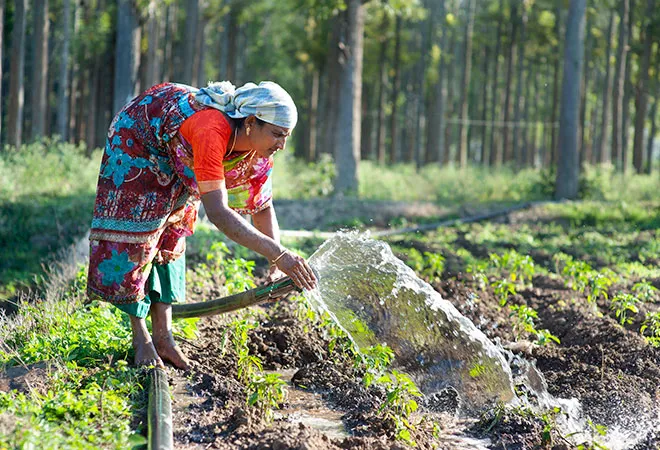
The proposed Interlinking of Rivers (ILR) project in India envisages to alleviate regional water scarcity through the transfer of water from flood-prone water ‘surplus’ to ‘deficit’ basins, through the creation of a water grid. Such links are aimed at mitigating floods and droughts hazards, augmenting agriculture production through irrigation, ensuring availability of water for drinking and sanitation, easing navigation and industrial development. The idea of ILR is primarily based on the notion that a river basin may be ‘surplus’ if the pattern of availability of water in the basin is in excess of the water requirement for various uses, over space and time. However, experts have raised concerns over the categorisation of river basins as either ‘surplus’ or ‘deficit.’ Such classifications, they argue, are not founded upon scientific arguments. It is difficult to ascertain the total water requirement in a particular river basin, and thereby its status as surplus or deficit, because it depends upon several factors such as agricultural, industrial and domestic demand for water in the region; hydroelectric generation, inland navigation, aquaculture, recreation and various other ecosystem services. The lack of reliable data entails that a comprehensive exercise of objectively calculating the total water availability and demand in a river basin is not possible. In fact, the notion of ‘surplus’ water has been challenged on the grounds that “every drop (of water) performs some ecological service all the time.” In light of the growing demand for water, and continued reduction in per capita availability, the objective of ensuring equity in the distribution of water resources across the country is noteworthy. But, diverting water from ostensibly surplus to deficit river basins may not be the best possible strategy.
The idea of ILR is primarily based on the notion that a river basin may be ‘surplus’ if the pattern of availability of water in the basin is in excess of the water requirement for various uses, over space and time.
Ecological and economic costs of ILR
Global experience of ILR have shown that plans for large-scale physical water transfers can adversely affect the environment, economy and livelihoods of people. The total costs of major ILR projects across the world is estimated to be around $2,653 billion. Out of the $532 billion estimated for water transfer projects in Asia, $125 to 200 billion is the construction cost of the ILR project in India alone. Megaprojects such as these are often high-risk projects because such large-scale engineering interventions need huge financial investments, and also demand long time frames from planning to completion.
Additionally, natural flow regimes and fluvial morphology are altered by the transfer of water, also reducing downstream water availability for agriculture and the ecosystem. It also contributes to salinisation and water table lowering in coastal areas. The gradual shrinking of the Aral sea has been cited as one of the most prominent examples of the adverse impact of engineering interventions in the natural course of a river. The Ken-Betwa Link Project in India has also hit a major roadblock due to the various social and environmental concerns that may make the project economically unviable. Construction of the dam across the Ken river at Daudhan is expected to adversely affect biodiversity of the Panna Tiger Reserve due to submergence. Further, the obstruction in the river flow is expected to result in lower sediment flows downstream.
Natural flow regimes and fluvial morphology are altered by the transfer of water, also reducing downstream water availability for agriculture and the ecosystem. It also contributes to salinisation and water table lowering in coastal areas.
Given the wide ranging costs of IBTs, it is imperative that planners and policy makers adopt an interdisciplinary approach to water resources management. This new interdisciplinary approach, known as Integrated Water Resource Management (IWRM), recognises ecosystem livelihood linkages and adopts a holistic eco-hydrological viewpoint to managing water resources. It propounds that supply side interventions such as transfer projects may not be sustainable given the limitations posed by the financial costs of the project, engineering complexities, and ecological processes of the global hydrological cycle. Instead, resorting to demand side managements that include improving water use efficiency and pricing of water may be more prudent and sustainable options.
Tradeable and non-tradeable aspects of ILR: A new perspective
Non-tradeable (NT) goods or services refer to those that require the production and consumption to occur at the same place. Flood and drought management, and providing access to drinking water and sanitation are some of the objectives which require water resources management in situ. These are the NT components of the ILR. Unless physical access to water is ensured, it would be difficult to provide drinking water and sanitation facilities. Similarly, mitigating the impact of floods would require planning and interventions at the place where the flood is likely to occur. These NT services of ILR can also be ensured through traditional and more cheaper methods of water conservation and management such as rainwater harvesting through tanks and ponds.
Flood and drought management, and providing access to drinking water and sanitation are some of the objectives which require water resources management in situ.
But, when it comes to the objective of transferring water, physically, over long distances for irrigation purposes, Virtual Water (VW) is a potential alternative, along with increasing irrigation water application efficiency, growing varieties of high yielding crop that require low irrigation, crop diversification and increasing yield in rainfed agriculture. The VW alternative presents itself essentially due to the highly tradeable nature of agriculture products. When goods or services are traded, internationally and domestically, it involves the movement of all the factors of production, including the water required to produce these products. The water embedded in these commodities is called VW, while its movement from one place to another, domestic or international, is called VW trade (VWT). Introduced by Tony Allan in 1993 to explain the imports of water intensive products in arid and semi-arid regions in the Middle East and North Africa, VWT has its foundations in the notion of comparative advantage (CA) propounded by David Ricardo.
If a country/region can produce a particular commodity at a relatively cheaper cost, it is said to have a CA in that product. CA is driven by the availability of factors of production. For instance, if a region is well endowed with labour resources, it is expected to have a CA in labour intensive goods and engage in the export of such commodities. Similarly, a water abundant region is expected to export water intensive products and contribute to VWT. In water scarce regions there are constraints to production of agriculture commodities, like food grains, especially during the lean season. In such cases VWT can play an important role as an alternative to the water required for agriculture in the water scarce region, as it does not entail the movement of water physically. Instead, it suggests that through imports of water intensive agriculture products, water stressed regions can optimise the use of their already scarce water resources, especially when agriculture sector accounts for 78 percent of water used in India.
VWT in reality: Water availability may not be the sole driving factor
Analysis of VW contents of some of the water intensive agricultural products traded within the sub-regions of India and China have, however, revealed exceptions to the notion of CA. For example, inter-state VWT, especially of food grains, has revealed an unsustainable pattern of water usage in certain parts of India. Punjab and Haryana, despite being among the most water stressed regions in the country, have been the source of a majority of water intensive food grains trade to water stressed states like Maharashtra and Tamil Nadu. Furthermore, food grains have also been exported from Punjab and Haryana to states that have more favourable agro-climatic conditions and water endowments for the cultivation of food grains, such as Assam and the Northeastern states. This ‘perverse’ direction of inter-state VWT in India has further intensified water scarcity in the already water stressed regions. Similarly, inter-province VWT in China suggest that the water scarce Northern provinces, accounting for only 20 percent of its water resources but two-thirds of farmlands, export agriculture products to the relatively water abundant southern provinces.
Virtual Water trade, at times, cannot be sufficiently explained only on the basis of water abundances or shortages.
Therefore, trade in agricultural commodities depends on factors other than differences in water endowments. Major drivers of trade are regional differences in availability and productivity of land, labour, knowledge and capital across sectors. These differences are often supplemented by the existence of input subsidy policies, access to markets and pricing. As a result, VWT, at times, cannot be sufficiently explained only on the basis of water abundances or shortages. For example, VWT from Punjab and Haryana reflect the continued support by the administration, through subsidised fuel for irrigation and price support mechanisms, towards water intensive agriculture practices. In China, market mechanisms better represent the productivity of land across sectors and regions, as compared to water.
This trend of unsustainable inter-state virtual water trade must be altered. Pricing and technology can be means to increase local water use efficiency. In the emerging paradigm of IWRM, optimal use of water resources must be made based on the prioritisation of various types of needs and demands for water, including ecosystem needs. VWT from relatively high to low water productivity regions would result in real water savings. It would be wise to suggest virtual water accounting in national and regional water and agricultural policy analysis. In this regard, VWT within countries can be viewed as an alternative to real IBTs, especially in the context of agricultural commodities, provided perverse direction of VWT is reversed.
The views expressed above belong to the author(s). ORF research and analyses now available on Telegram! Click here to access our curated content — blogs, longforms and interviews.




 PREV
PREV



